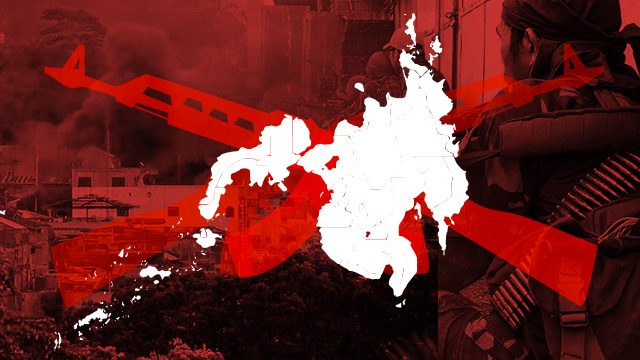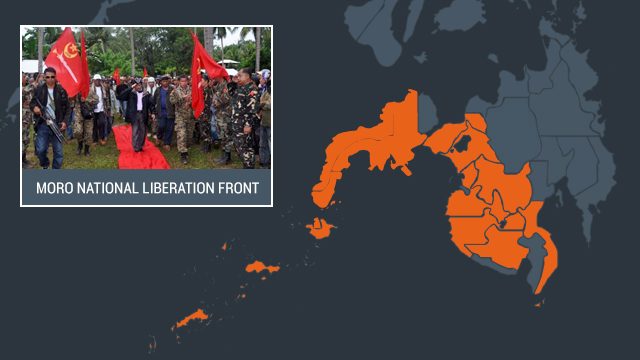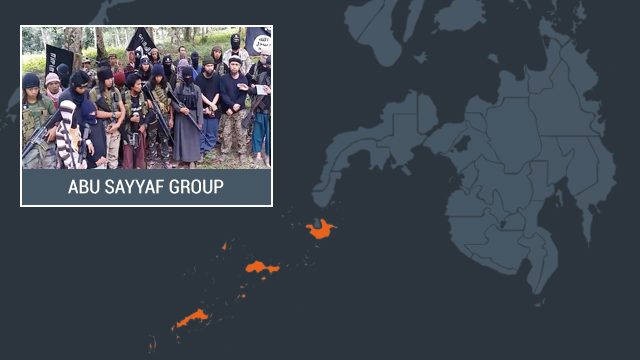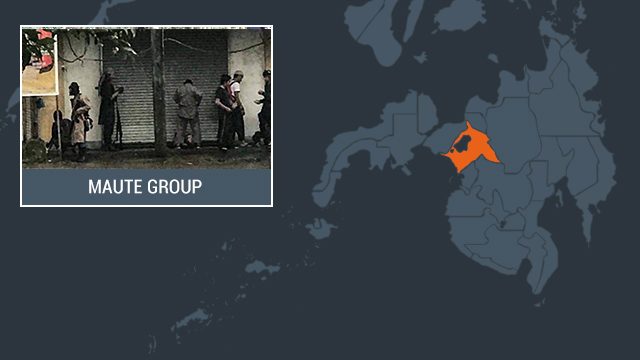SUMMARY
This is AI generated summarization, which may have errors. For context, always refer to the full article.

MANILA, Philippines – On May 23, President Rodrigo Duterte declared martial law in Mindanao for 60 days, following clashes in Marawi City between government troops and the Islamic State (ISIS)-inspired Maute terror group.
This was the first time martial law was declared since 2009, when then-president Gloria Macapagal-Arroyo put Maguindanao province under martial law following the Maguindanao massacre. (READ: Martial Law 101: Things you should know)
But Arroyo’s declaration of martial law covered only one province. Duterte’s declaration covered the entire island of Mindanao, even if the clashes triggering the declaration centered only on Marawi City, a city of around 201,000 people with a land area of 87.55 square kilometers. (READ: Questions you need to ask about martial law in Mindanao)
The government justified its decision, citing other security threats that need to be addressed in other parts of Mindanao, not just in Marawi City.
“There are also problems in Zamboanga, Sulu, and Tawi-Tawi, also in Central Mindanao. We also have some problems in Region XI, [extortion] of the NPA,” Defense Secretary Delfin Lorenzana said in a press briefing last week.
“Sabi nga ni Presidente, he has been telling this before na if I declare martial law, tatapusin ko lahat ng problema so kaya nga buong Mindanao na,” he added.
(The President has long been saying that if he declares martial law, he will end all the problems, so that’s why the entire Mindanao was included.)
A day after declaring martial law, Duterte said he did so because of the threat of ISIS.
The troubled southern island has a long history of conflict and violence. Its 27 provinces have faced – and continue to face – a host of security threats: the radical terrorist group Abu Sayyaf Group (ASG); the Moro Islamic Liberation Front (MILF), and the Moro National Liberation Front (MNLF); communist rebels from the New People’s Army (NPA); and the terrorist Maute Group, based in Lanao del Sur.
The MNLF is the mother group of both the ASG – which broke away in 1991 – and the MILF, which is now engaged in peace talks with the government.
According to the Philippine Center for Investigative Journalism, the MNLF operates in Basilan, Davao del Sur, Lanao del Norte, Lanao del Sur, Maguindanao, North Cotabato, Sarangani, South Cotabato, Sultan Kudarat, Sulu, Tawi-Tawi, and in the Zamboanga Peninsula. The ASG, meanwhile, is mostly active in Basilan, Sulu, and Tawi-Tawi.
Aside from these groups, rido or clan wars are also common, particularly in the Autonomous Region in Muslim Mindanao (ARMM). According to a 2007 book published by The Asia Foundation (TAF), nearly 1,300 rido cases were recorded between the 1930s and 2005, killing more than 5,500 people in 11 Mindanao provinces.
These clan wars have been ongoing even before terror threats arose, with some of the earliest rido cases recorded taking place in the 1930s.
Rappler looks at the different security threats facing Mindanao’s 27 provinces.
Zamboanga Sibugay
Zamboanga Sibugay has suffered from attacks from the MILF, with its rebels responsible for staging ambushes on government troops. The MNLF also has its presence via Commander Enier Misuari, nephew of MNLF founder Nur Misuari, a known figure in the province. Enier Misuari was captured in September 2013.
Earlier this month, the military clashed with NPA rebels, resulting in the deaths of two commanders.
Zamboanga del Norte
The MILF threat has long been ongoing in Mindanao, prompting the Zamboanga del Norte governor in 2008 to arm civilians for their protection.
Zamboanga del Norte has faced threats from the MILF. The group has maintained a camp with battalion-size fighters in 4 towns in the provinces – Sirawai, Sibuco, Siocon, and Baliguian. In January this year, rogue members of the MILF attacked a detachment of the Army’s 42nd Infantry Battalion in Barangay San Vicente. In 2015, several towns in the province were classified as areas with a high terrorist threat.
Zamboanga del Sur
Zamboanga del Sur is a risk area for attacks by the MILF, MNLF, and NPA rebels. Just last month, NPA rebels killed the barangay captain of San Miguel town. In November 2016, two soldiers were killed in an ambush in Barangay Guinicolalay. In July 2014, soldiers were also attacked by NPA rebels in the town of Tigbao.
In September 2013, nearly 500 MNLF members attacked Zamboanga City, leading to a standoff with government forces. It happened about 12 years since Misuari and his followers also took hostages in the city, in what became known as the Cabatangan siege.
Region X – Northern Mindanao
Misamis Occidental
NPA attacks have been occurring in recent years in Misamis Occidental. In December 2013, 100 NPA rebels raided a police station, taking weapons with them. In March 2017, government forces managed to capture an NPA camp in Tudela town.
Bukidnon
Waves of NPA attacks in Bukidnon have been seen in recent years. The communist rebels targeted a hydropower plant project in Valencia City in February 2017, as well as plantations and offices of Del Monte Philippines in February 2013 and January 2016.
The rebels have also resumed attacks against government forces since the NPA ended its unilateral ceasefire in February 2017.
Lanao del Norte
In 2008, clashes broke out between the MILF and government forces, with the rebels trying to overrun a militia detachment and attacking military positions because of the delay in the implementation of a memorandum of agreement on ancestral domain.
In January 2017, the Philippine defense chief confirmed that ISIS leadership communicated with Abu Sayyaf senior leader Isnilon Hapilon, who had been monitored moving from his base in Basilan to Lanao del Norte.
Misamis Oriental
Misamis Oriental has suffered from NPA attacks. Among the fatalities was a private first class in Sugbongcogon town in February 2017. NPA attacks have been common in recent years: the attack on a supposed “insurgent-free” town in August 2015, and an attack on a police station in the town of Medina in August 2011, among others. In November 2015, the rebels released a prisoner of war in Sugbongcogon.
Camiguin
In February 2015, local officials declared the province “insurgency-free” and ready for development, noting that there had been no recent violent incidents initiated by terror groups in the area.
However, it was among the areas listed in a travel advisory issued by the Australian embassy in April 2017 to warn against the possibility of kidnappings.
Davao Oriental
Following the end of the NPA’s unilateral ceasefire in February 2017, communist rebels clashed with the Armed Forces of the Philippines (AFP) in separate attacks around the country. Last month, the NPA staged an attack at a major tourist attraction, the Aliwagwag Falls. A clash between the NPA and government forces also took place in Mati City in March 2017, while another attack was also reported in Capiz, Davao Oriental in February 2017. The most recent attack was staged last May 9 at the Mil-Oro Mining Corporation, which the NPA said, was “punishment” for the mining firm’s negative impact on the environment.
Compostela Valley
In 2015, the Philippine Army said Compostela Valley was the number one province affected by insurgency, with communist rebels numbering between 300 and 400. But a year later, the province was declared “conflict-manageable and development-ready.”
The army said the success of its operations was largely due to the implementation of its Internal Peace and Security Plan (IPSP), which focused on boosting security in Compostela Valley’s 11 municipalities.
Sporadic clashes still occur, however. In August 2016, some 20 soldiers engaged 60 rebels in a gunfight. In February this year, the Army said NPA rebels abducted 4 civilians in the province.
Davao del Sur
While Davao City itself is no longer on lockdown, following the Marawi crisis, much of the Davao Region continues to remain an area of security concern. In September last year, an explosion ripped through the Davao City night market, an attack blamed on the Maute Group. Insurgency concerns are also present: earlier this year, 300 families fled their homes as the military clashed with NPA rebels, and 4 Davao cops were killed in an NPA attack in March. The rebels’ attacks in Davao City last month was also labeled by Mayor Sara Duterte-Carpio as “acts of terrorism.”
Davao Occidental
The NPA has been active in the province in the last couple of years, although dozens of rebels have surrendered in the face of the government’s all-out offensive against NPA hideouts. In recent months, minor clashes between the NPA and government forces continued to be reported regularly with the AFP sustaining casualties as well.
Davao del Norte
In September 2015, the Abu Sayyaf kidnapped 3 foreigners and a Filipina from a resort in Samal Island, Davao del Norte. The province has also seen several skirmishes between the military and communist rebels, with casualties being inflicted on both sides. In July 2016, NPA rebels staged an ambush on members of the CAFGU Active Auxiliary, despite the government’s declaration of a unilateral ceasefire. The NPA, however, blamed the military for the attack.

Region XII – Soccsksargen
South Cotabato
South Cotabato is another area of concern for the AFP as it has seen sporadic NPA activity in the past 3 years. Notable NPA activities in South Cotabato in 2016 included an armed clash with government forces in Koronadal City in which two NPA members were killed; and the burning of buses and heavy equipment, among other incidents. One of the most recent incidents is the NPA attack on a CAFGU unit in Barangay Tablu, Tampakan in March 2017.
Sultan Kudarat
Soldiers have engaged NPA rebels in the province who were allegedly collecting “protection money” from locals. In March, a Philippine Marine was killed and 8 others wounded in an NPA ambush in Kalamansig. Follow-up operations in Barangay Hinalaan also resulted in 6 NPA rebels killed. In April, at least 15 people were hurt when an improvised explosive device detonated in a business establishment. Previous reports said that prior to the blast, text messages had circulated warning of a bomb plot by the Bangsamoro Islamic Freedom Fighters (BIFF), a breakaway faction of the MILF.
North Cotabato
This province is best known for the major confrontation that occurred in 2008 between rogue MILF rebels under Umbra Kato and the AFP. The armed group attacked civilian communities in 5 towns in the province, occupied farmlands, and burned houses, displacing more than 150,000 people.
In 2013, the MILF clashed with the MNLF in Matalam, North Cotabato, prompting 50 families to flee their homes.
Other than the MILF and the MNLF, the NPA has also been known to operate in the province. Last March, armed men claiming to be affiliated with the NPA burned a bus traveling between Marbel and Davao City. NPA members also clashed with soldiers last January in Makilala town, breaking the 5-month ceasefire between the two sides. Eight soldiers and an NPA rebel were killed in the hour-long firefight.
Sarangani
Military forces have battled MILF factions in the province, as well as NPA rebels. In February 2015, a high-ranking NPA leader was killed along with 4 others in a clash in Alabel, Sarangani.
One of the most significant anti-terror successes to date was the killing of a top leader of a local terror group. Mohammad Jaafar Maguid or “Tokboy” of the Ansar Khalifa Philippines (AKP) was killed in January 2017 following an inter-agency operation led by the National Intelligence Coordinating Agency (NICA) and police.
Maguid and his followers pledged allegiance to ISIS in 2015, and established links with Indonesian terrorist group Jemaah Islamiyah.
AKP is also believed to be behind threats against the APEC Summit in Manila in November 2015.
Region XIII – Caraga
Agusan del Norte
The province has been experiencing NPA activity in recent months. In March 2017, 300 residents fled their homes following an NPA attack on Barangay Hinimbangan, Kitcharao town. Even prior to the attack on Hinimbangan, NPA elements clashed with government forces earlier in February.
Agusan del Sur
Government troops continue operations against communist rebels in Agusan del Sur. Earlier this May, a high-ranking NPA leader, Rany Gargar Undayon of Guerrilla Front (GF) 19, was arrested by soldiers in Prosperidad, Agusan del Sur.
Rebels from the NPA’s Front Committee 14 also recently kidnapped businessman Carzon Ceasar Lademora, son of a former Agusan del Sur town mayor.
Surigao del Sur
In January 2016, the Philippine Army deployed 500 troops to the province to fight communist guerrillas, in the area which serves as the base of Jorge Madlos, the spokesman for Mindanao of the communist-led National Democratic Front. Governor Johnny Pimentel said Surigao del Sur and Agusan del Sur are the strongest bailiwicks of the NPA.
The communist rebels began gaining ground in the province in 1989, but weakened after military offensives. The group however managed to recover in the middle of the 2000s.
Surigao del Norte
Surigao del Norte continues to face the threat of attacks by communist rebels. In March, the NPA reportedly detonated an IED in Malimono town, and engaged the military in a gunfight. The military also said residents claimed the rebels were harassing them and extorting money.
Earlier in February, NPA rebels were injured in a 15-minute firefight with soldiers, after Duterte ended the government’s 6-month ceasefire with the NPA following a series of clashes, with each side claiming the other violated the ceasefire first.
Dinagat Islands
Dinagat Islands, one of the country’s newest provinces (created in 2006) is relatively free from security threats.
In February 2016, the Philippine Army said there were no NPA-initiated incidents monitored in the province since January 2015.

Autonomous Region in Muslim Mindanao
Sulu
Sulu is the lair of the notorious Abu Sayyaf Group, responsible for a spate of kidnappings and gruesome beheadings.
The ASG, which split from the MNLF, has its strongholds in Basilan and Jolo, Sulu. It was established in the early 1990s with seed money from Osama bin Laden’s Al Qaeda network, and has been responsible for more than 100,000 deaths since the 1970s.
The military has been issued the directive to go after the ASG, with about 8,000 troops deployed to Jolo, Sulu, according to Rappler sources.
In 2016, the ASG beheaded a Canadian hostage. He was one of 22 foreign hostages held by the terrorist group in Sulu.
The ASG’s most senior ideological leader, Isnilon Hapilon, has also pledged allegiance to ISIS.
Aside from the threat of the ASG, rido cases are also prevalent in the province. The 2007 TAF book noted that rido cases have been recorded since the 1940s, and have occurred in every city and municipality in Sulu. Property and land disputes were the top causes behind the 145 clan feuds recorded in the study.
Tawi-Tawi
In March, the military said the ASG killed one of 6 Vietnamese sailors abducted off the Pearl Bank near Tawi-Tawi in February 2017.
In March, a sub-leader of the ASG, Buchoy Hassan, was killed in military operations.
In 2012, two European birdwatchers were abducted in Tawi-Tawi. Sources told Rappler that the two were later brought to Patikul, Sulu, with the transfer allegedly coordinated by MNLF commander Tahil Sali and Abu Sayyaf leader Radullan Sahiron.
Basilan
The ASG is active in Basilan, with clashes between ASG members and government troops still occurring in recent weeks.
Earlier this month, Joint Task Force Basilan was able to track down and capture the ASG’s temporary encampment in Barangay Pamatsaken, Sumisip municipality, which is believed to be harboring ASG sub-leader Furuji Indama.
In April last year, the military engaged the ASG in a 10-hour gunfight in Tipo-Tipo, Basilan, resulting in the deaths of 18 soldiers. A terror expert said ISIS was behind the attack – its first major attack in the Philippines.
The military has also had clashes with the MILF in Basilan. In 2011, 19 soldiers of the Army’s Special Forces were killed by MILF rebels in Al-Barka, Basilan. In 2007, 23 Marines were killed in clashes with the MILF, with at least 14 of the soldiers beheaded.
In this province, rido cases were also recorded as early as the 1970s, with cases occurring in every city and municipality. At least 60 feuds were recorded, according to the 2007 TAF study, resulting in about 377 deaths.
Maguindanao
The MILF’s main camp is Camp Darapanan in Sultan Kudarat, Maguindanao. The group is currently engaged in peace talks with the government.
Also a threat in the province is the BIFF, which broke away from the MILF over disagreements with the latter accepting autonomy instead of independence from the government.
In 2014, the military said it captured several strongholds of the BIFF in the province.
The AFP also said the BIFF has been allied with the private armed group of the late Andal Ampatuan Sr, former Maguindanao governor, since 2009.

Lanao del Sur
The Maute Group, led by the Maute brothers who grew up in Butig town in this province, has been active in Lanao del Sur since 2015. In 2016, they were responsible for a series of attacks in the province, establishing strongholds and occupying the town of Butig. They are also accused of being behind the September 2016 bombing at a Davao City night market.
It was in Marawi City, capital of Lanao del Sur, where the Maute Group clashed with government troops in May 2017, prompting the President to declare martial law in Mindanao.
Aside from the Maute Group, Lanao del Sur also faces the problem of clan wars. A 2007 study found that 337 rido cases were recorded from 1994 to 2004 – with most happening in 2004, a year where national and local elections took place. The top causes were political rivalries, land disputes, pride, retaliation, accidents, and drug-related motives. – with Ishbelle Bongato and Carlos Victa / Rappler.com
Ishbelle Bongato and Carlos Victa are Rappler interns.
Add a comment
How does this make you feel?
There are no comments yet. Add your comment to start the conversation.